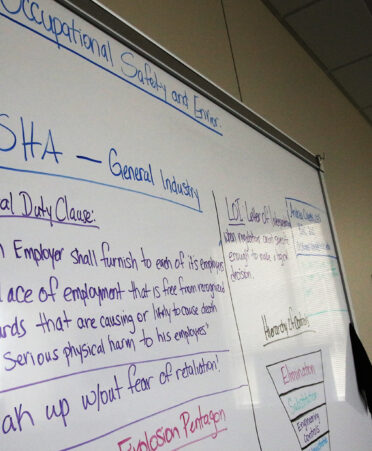June is National Safety Month
(ROSENBERG, Texas) – While June may mark National Safety Month, highlighting safety topics including musculoskeletal disorders and slips, trips and falls, Andrea Skinner-Creeks, a Texas State Technical College Occupational Safety and Environmental Compliance instructor, focuses on workplace safety year-round.
Leveraging her industry background, Skinner-Creeks helps train the next generation of occupational health and safety technicians at TSTC. These future graduates will go on to help ensure that workplaces remain safe for all employees.
National Safety Month, an initiative by the National Security Council, offers an opportunity to raise awareness of workplace safety. Each week of June highlights a different topic, including:
— Musculoskeletal disorders, a leading cause of workplace injury.
— Workplace impairment, which covers the dangers of substance abuse and raises awareness of how stress and fatigue can also be impairments.
— Injury prevention, which includes identifying hazards and assessing risks.
— Slips, trips and falls, the second-leading cause of unintentional injury-related deaths.
Musculoskeletal disorders can occur when workers engage in repetitive motions — such as lifting without using the proper form or handling a tool that has an awkward angle, thereby putting strain on a joint. Such disorders can range from minor to severe. For example, a minor disorder, like sciatica, may be relieved through massage therapy. A major disorder could include an injury that can only be corrected through surgery.
“Musculoskeletal disorders are a real problem in industry,” Skinner-Creeks said. “The older you get, the less resilient your body is. Those disorders can require ongoing treatment.”
What some people may not realize is that musculoskeletal disorders can occur just as easily in an office as in a manufacturing plant or on a construction site.
“I can hurt myself at this desk, believe it or not,” Skinner-Creeks said, demonstrating the proper hand height over her keyboard as well as how her computer monitor should be positioned to avoid neck strain.
Industry solutions have included desks with adjustable heights, ergonomic chairs and cushioned mats to take pressure off knees and backs for employees who spend most of their workdays standing.
“It’s the company’s job to protect the employee,” Skinner-Creeks said.
Slips, trips and falls are also prevalent.
“When I worked in the field, I had to keep telling technicians, ‘Tie your boots,’” Skinner-Creeks said. “That is a near miss. Wear the appropriate shoe for the appropriate ground. We have to be mindful. If you go on a field visit, make sure you have the PPE (personal protective equipment).”
Skinner-Creeks knew someone who injured their ankle because of an uneven surface — a “housekeeping” issue that can also include spills and other hazards.
These issues — and many more — fall under the umbrella of injury prevention as a whole, which can also include training.
“Training them on hazards, training them on what PPE to use, training them on when to take action, when not to take action — it’s a lot,” Skinner-Creeks said.
TSTC offers training in Occupational Safety and Environmental Compliance at its Breckenridge, Fort Bend County and Waco campuses.
Onetonline.org predicts that the number of occupational health and safety technicians will grow in Texas by 16% through 2028.
Texas employs the highest number of occupational health and safety technicians in the country, and the Houston-The Woodlands-Sugar Land metropolitan area has the third-highest employment level for these positions in the nation.
Registration for TSTC’s fall semester is underway. Learn more at tstc.edu.
